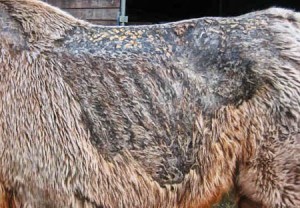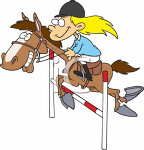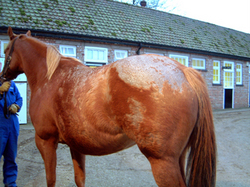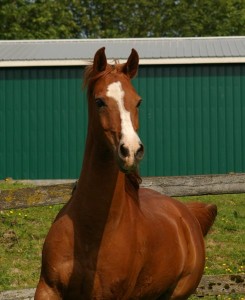Archive for the ‘Uncategorized’ Category
The Earth Horse Temperament Type
The young Earth horse temperament is born with a willingness to get along and give all he has. The earth horse will often seem to train himself, especially if he is treated with kindness. Earth horses are easy keepers but they love food. A simple diet and moderate work load is best for the Earth horse. Treats will go a long way in assuring their cooperation and excitement about the partnership. With clear boundaries, the Earth horse will respect you and not mug you for food. Over working the Earth horse will destroy his natural good attitude. Earth offers up its fertile bounty when it contains the correct amount of moisture. With too much water you have a muddy, useless piece of land. With too little moisture you get cracked hardpan. Completely waterlogged land can give way and cause severe mudslides. Driven by wind, dry dirt can become a gritty dust storm.
The Earth horse has a tendency to retain too much water in his system. This excess dampness can cause him to be dull and slow. Too much fat and rich food can lead to excess dampness and the health challenges that are related. Stocking up in the legs is a common sign of dampness in the Earth horse. Internal signs of excess dampness include frequent head colds with thick nasal discharge and susceptibility to parasites. If the Earth horse has too little moisture you will see a dry coat and brittle hooves.
The Earth horse is honest and solid and when his giving nature is honored he will be a willing, long term partner. Born wanting to get along, the Earth horse is a great backyard, family horse. His needs are simple, a basic low-carb, low-fat diet and enough good quality forage to support his weight. Treats will make the Earth horse look forward to working for you and if you set boundaries he will not get pushy. Watch for signs of dampness and make adjustments in feeding practices that are appropriate to his temperament.
In essence, if you take care of your Earth horse, he will take care of you.
Want More Info?
Learn about each of the 11 different horse temperament types in the Horse Harmony book, online test, and resources. You can access all of these by clicking the web addresses below. Be sure to scroll all the way down the pages to access all the fun available resources:
www.HorseHarmony.com
www.HorseHarmonyTest.com
http://facebook.com/HorseHarmony
http://youtube.com/HorseHarmonyTypes
Helping Hormonal Mares
We are back! After a few weeks of technical problems with the blog all is resolved and we are back to bringing you articles every week…Enjoy! 🙂
This article was featured in Riva’s Remedies March 2012 Newsletter and I wanted to share it with all of you. I’m sure we have all, at some point dealt with a moody mare! We have a very hormonal mare that greatly benefits from these herbal treatments. Hope this helps you too!
——————————————————-
Helping Hormonal Mares
By Marijke van de Water, B.Sc., DHMS
Many mares exhibit hormonal problems through mood and behaviour changes. This is often seen during a mare’s cycling days, however many mare owners report this behaviour even when they are not cycling. Unfortunately, too many times we have simply attributed this to “mares being mares”, and have not recognized that these horses are not feeling well and that they can suffer from the same anxiety, irritability, aggression, sadness and depression as women do during PMS or an unhealthy menopause. These emotional symptoms can make it very hard for mares to tolerate being handled or ridden, or to cooperate with other horses. And, unfortunately it often gets dismissed as a training problem.
Hormones are powerful chemicals that have a profound effect on the neurotransmitters of the brain: estrogen has an excitatory effect on the brain, increasing serotonin and acetylcholine levels whereas progesterone has a more calming effect. Serotonin is responsible for creating positive moods and acetylcholine is necessary for focus and memory.
As with humans, diet can be an important factor – high-sugar feed such as oats or sweet feed will exacerbate hormonal symptoms. Horse owners also report that high quantities of alfalfa can negatively affect behaviour as well. (For humans, caffeine and dairy products are the most common culprits with PMS and menopausal symptoms.)
For a hormone balancer and calmer the Riva’s Herbal Blend for Mares is an effective remedy. It contains Blue Cohosh, Black Cohosh, Licorice Root and Chamomile to tone the ovaries and sooth the nerves. This blend will also help to regulate erratic cycles, ease uterine cramping and/or to increase fertility – although it is not advisable to feed it during pregnancy.
The best nutritional supplements are Vitamin B6 (800 to 1,000 mg daily) and Riva’s Primrose Oil (4,000 mg daily).
Vitamin B6 is essential for the synthesis of both hormones and neurotransmitters and has the added benefit of regulating blood sugar levels. It will also support pituitary and thyroid function.
Riva’s Primrose Oil also helps to synthesize hormones, and is a natural anti-inflammatory and immune stimulant. Both of these nutrients can be used with the Herbal Blend for Mares and are also safe to feed during pregnancy.
If the thyroid or pituitary glands need extra support, use Riva’s Hormone+Boost to stimulate and tone the entire glandular system, to optimize metabolism, improve immunity, relieve stress, and enhance mental and emotional well-being. It contains Ashwaghanda, Chaste Berry, Kelp, Licorice Root and Raspberry Leaf.
Once the hormones are stabilized but a mare is still uncooperative then the training program should be assessed. Some horse owners have allowed their behaviour to become a pattern, in which case competent but compassionate handling will help them re-learn a healthier attitude. And don’t put food down in front of “cranky” mares until their ears come forward – this might take time at first but they will learn to “smile” to get fed. In fact, don’t let them eat at any time during handling or riding as many horses will consider this as dominance. With good food, supplements and common-sense handling most mares will become happy and healthy partners.
Some moody mares are simply trying to express that they want to have a baby, after which their hormones “settle down”. There are no guarantees though…and if you choose to breed make sure that you can provide the foal with a permanent home for life; we already have too many unwanted horses that end up in situations of neglect and/or abuse.
Click here to see this article in its entirety on Riva’s Rememdies Website: http://www.rivasremedies.com/hormonal_mares.php
Marijke van de Water, B.Sc., DHMS
Equine Health & Nutrition Specialist
Homeopathic Practitioner
Medical Intuitive & Healer
Author of two books:
Healing Horses: Their Way!
Healing People: The Marijke Method
Rain Scald Explained
Written By– Dr. John Kohnke BVSc RDA.
Talking Horses Equestrian Issue 22
Rain Scald or ‘mud fever’ is a common skin condition which is favoured by wet weather. The common cause is a fungal-like organism (Dermatophilus congolensis) which colonises the skin of horses, cattle and sheep. 
Horses which share pastures with sheep or cattle often have a higher risk of rain scald or even ‘greasy heel’, which is also caused by the same organism, combined with skin reaction to sunlight on non-pigmented skin (horses with white socks on their hind fetlocks and pasterns).
Although it is a soil contaminate, it is difficult to culture the fungal-like organism from soil in muddy areas. Studies have shown that the common black house fly Read the rest of this entry »
THE POWER OF PLAY WITHOUT PRESSURE..
By Faye Birkin
 Sometimes we as riders, lose sight of the concept of riding just because we love it. We get stuck in the rut of thinking that we always need to be doing something ‘worthwhile’ like schooling, training, working towards a showing event or sometimes even that awful ‘obligatory feeling’ of having to ride because we feel bad that we haven’t ridden enough and our horse needs to ‘get out’.
Sometimes we as riders, lose sight of the concept of riding just because we love it. We get stuck in the rut of thinking that we always need to be doing something ‘worthwhile’ like schooling, training, working towards a showing event or sometimes even that awful ‘obligatory feeling’ of having to ride because we feel bad that we haven’t ridden enough and our horse needs to ‘get out’.
I guarantee you that your horse doesn’t care about all these reasons in the slightest. The only thing he can really appreciate is when you spend quality one-on-one time with him. No pressure, no expectations, no rules or preconceived ideas… just being one with him.
It is often during these un-structured, un-scheduled and un-forced moments, that the greatest Read the rest of this entry »
NEW YEARS RESOLUTIONS FOR THE HORSE RIDER
There is a saying that if you always do what you’ve always done, you continue to get what you’ve always got. This applies to every aspect of life, but is particularly true of riding.
It is easy to carry on doing what we’ve always done – after all some of us learned to ride years ago and are unaware that we may have developed bad habits, perhaps to compensate for physical changes in our bodies, or not realizing that we are capable of riding more effectively.
Horses that continually do the same thing quickly become bored and unmotivated. This January, why not resolve to put some sparkle back in to your lives and try something new?
You will be surprised at just how much fun and enjoyment you can have, and how your confidence and relationship with your horse can be strengthened, simply by stepping out of your comfort zone.
Here are ten ways to ensure that 2012 really is a happy new year!… Read the rest of this entry »
A Mid-week Chuckle
I would like to begin an “Equine Glossary” soon since there are literally 1000’s of equine related words, (both slang and actual) that we as horse-owners hear and use every day. Even after owning horses practically my whole life I still hear words now and then that I dont know!
Before we do that however, I would like to share a more humourous side of the Equine Glossary with you…please note that these definitions are only meant to entertain not inform…;-) 
- Auction
- A popular, social gathering where you can change a horse from a financial liability into a liquid asset.
- Azoturia (Monday Morning Disease)
- a condition brought on by showing horses all weekend. Symptoms include the feeling of dread at having to get out of bed on Mondays and go to work.
- Barn Sour
- An affliction common to horse people in northern climates during the winter months. Trudging through deep snow, pushing wheelbarrows through snow and beating out frozen water buckets tend to bring on this condition rapidly.
- Big Name Trainer
- Cult Leader: Horse owners follow them blindly, will gladly sell their homes, spend their children’s college funds and Read the rest of this entry »
The Curse that is Rain Scald
Fall has well and truly set in here on the Lower Mainland…and it looks like it is going to be a very wet AND humid one! Perfect conditions for the dreaded ‘Rain Scald’ also known as:
- Rain Rot
- Streptothricosis
- Mud Fever
- Dew Poisoning (when its on the legs)
Here is an article on what Rain Scald really is, how to prevent it and how to treat it.
———————————————————————-
By Cheryl Sutor
What is rain rot?
Rain rot is one of the most common skin infections seen in horses. It is also referred to as “rain scald” or “streptothricosis”. The organism that causes rain rot appears and multiplies in warm, damp conditions where high temperature and high humidity are present. This condition is not life-threatening, so don’t worry. However, while the horse has rain rot, any equipment that may rub and irritate the infected skin (such as saddles and leg wraps) should be eliminated.
What causes rain rot?
The organism dermatophilus congolensis causes rain rot. dermatophilus congolensis is not a fungus. It is an actinomycetes, which behaves like both bacteria and fungi. Most people believe that the organism is present in soil, however, this has not been proven. The organism is carried on the horse, who has it in his skin. A horse who has this organism in his skin may or may not be affected.
What does rain rot look like? Read the rest of this entry »
Introduction to Klaus Ferdinand Hempfling
| A Note from Faye- This is of course, just my opinion- but I believe Klause Ferdinand Hempfling to be the epitome of what we, as natural horsemen and women are trying to achieve. His connection with the horses he works with is astounding and genuine. He has unlocked the secret to TRUE horsemanship that 100’s of years of “Traditional” Horsemanship destroyed and buried. He is endevouring to bring us back to the realisation that horses are so much that ‘sport mounts’ and ‘creatures to be dominated’. I hope you will enjoy the brief biography and introduction to his work and I hightly reccomend that you all at least buy (or borrow) first book ‘Dancing with Horses’ .
I have also added a very recent clip below of Klaus working completely at liberty with a Lippizaner stallion. It gives me goosbumps everytime I watch it! ——————————————————– [youtube]http://www.youtube.com/watch?v=zq06bmJLt-U&feature=pyv&ad=10609930901&kw=horses[/youtube] Klaus Ferdinand Hempfling was born in Germany in 1957. After completing a degree in telecommunication technology, he took the time to deepen his understanding of life by becoming a teacher, freelance artist, theatrical director and traveler. Read the rest of this entry » |
Farewell to Prince of Light
Greetings to All
It is with a heavy heart that I greet you today, as just yesterday, we said goodbye to the oldest and most beloved member of our herd- Prince of Light.

Prince came to us 4 years ago, on a cold & soggy day weighing a mere 500lbs soaking wet. At 40 years old, Prince had slowly been starving to death after being abandoned in a field, unable to eat since his teeth were all worn away.
Although his body was weak, his spirit was tenacious and over the next few months, we came to know the fiercely independent, strong-willed, yet gentle & wise soul that he was. His ‘don’t fence me in’ outlook on life led to us to customize our setup so that he had free rein to paddocks and fields and slowly, he regained his strength until no one would believe he was a horse in his mid 40’s.
Over the last 4 years Prince has watched over his herd of horses & humans with possessive dedication and his love of life was infectious & inspiring. Prince was a healer and guide to many women who had lost their way. He will never be forgotten.
Today we won’t say Goodbye, but rather, Farewell.
We will meet again.
————————–
And this from Linda-Ann…
Dearest Prince of Light,
Today you passed into the heavens with the same dignity that you brought into my life. Like the mighty oak tree you stood guard over each of us – never faltering with your watchful heart. A sudden sound, something slightly out of place and your vigilance became ever apparent. You were more than a horse to me. When you stepped off Kevan’s trailer only a few short years ago, you instantly owned Healing Heart Sanctuary and my heart. I almost lost you a few weeks after that as you lay in my arms colicking. I thought you were gone, but that strong spirit pulled you through. As my heart breaks this evening, I know you are still watching – watching from a new place. You have joined your MJ and I know you are whinnying together again.
Thank you for giving me and so many other women, your gift of grace, purity and absolute unconditional love. We will always dance together as our souls are forever entwined in the richness of your spirit. You are in a place where you can be truly free at last!
————————–
The Ancient Elegance Of Arabian Horses In The Modern World
As an avid Arabian lover I am blessed with 2 arab geldings who make every day special. Their loving attitudes, expressive eyes and forgiving natures inspire me to constantly learn more.
Here is a brief introduction to my 2 boys…
Copper chestnut with 4 white socks and a blaze, I also suspect he has the Sabino gene since he will periodically sprout thrick white streaks in his mane, or spots on his body that start out the size of pennies and end up the size of toonies. Read the rest of this entry »



